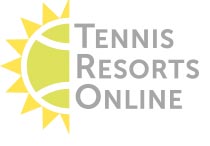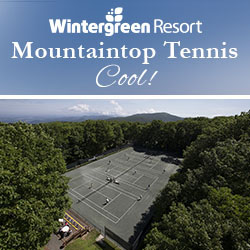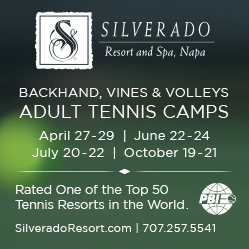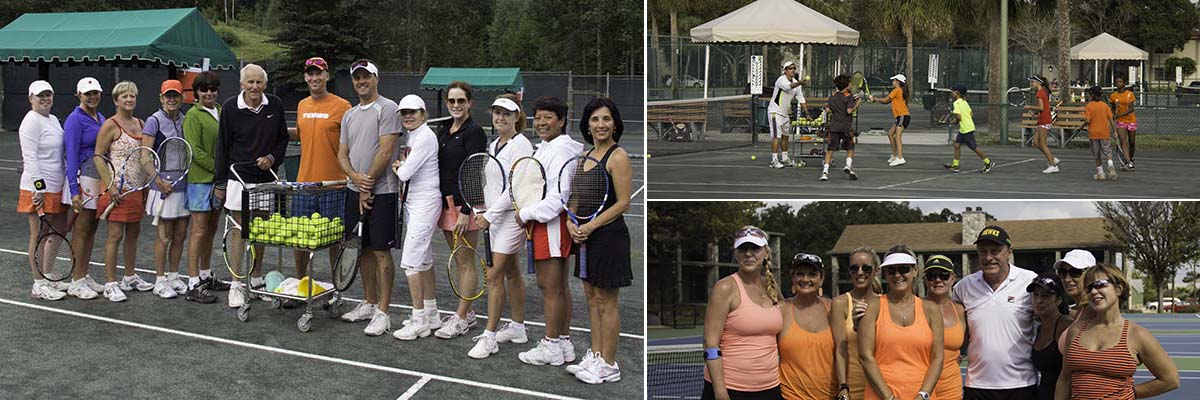
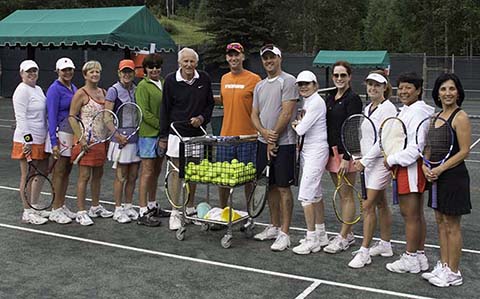
Top 10 Tips For Tennis Group or Team Vacations
If you scan the reviews of resorts and camps on Tennis Resorts Online, you'll frequently come across entries like "I took a group of 12 ladies to …" or "8 of us are just back from …". Going on a tennis vacation as a group—whether friends or teammates—not only affords the opportunity to indulge a passion for tennis together in the relaxed atmosphere of holiday resort or camp but can also be much more economical. Numbers give you leverage to negotiate a custom-designed bundle tailored to your group's specific preferences. True it requires some extra effort on the part of the organizer, who needs to pull together the potential participants, get them to agree on a date, and then negotiate a package with the resort or camp. But once that's all set, everyone can look forward to to the holiday, knowing that as a group, they'll get special attention.
![]() If you're looking to put a group together, here are the crucial elements to keep in mind:
If you're looking to put a group together, here are the crucial elements to keep in mind:
- Who's interested? Start by putting together a list of potential participants. Compatibility matters, since you'll be spending a lot of time together. If the group is small, it helps also helps if playing abilities are relatively similar, though for obvious reasons that's not an issue for teams.
- In-Season or Off? Although your first impulse may be to head for somewhere sunny when your city is blanketed in snow, or to the mountains when you'd otherwise be sweltering in heat, you'll pay a premium price and may lose flexibility by traveling in high season. Group trips are both easier to book and more economical during the shoulder and low seasons (shoulder season in New England, the Rockies, or Sierras is late May and June and after Labor Day—though in New England it ends with the arrival of fall foliage season). In general, the tennis staff has more flexibility to negotiate lodging rates during periods when there a reduced demand for rooms. Restaurants are easier to book as well, especially if you're all going out together. Granted, there may be trade-offs: at a beach resort the water may not be so appealing if the ocean is chilly. On the other hand, daytime temperatures will probably be ideal for tennis.
- Driving or flying? Apart from the obvious difference in cost, having to fly to a resort means you'll need to make plans farther in advance to secure the best airfares and will probably want to stay longer than just a weekend.
- What dates work? Poll your friends or teammates about preferences for weekends or midweek and the ideal number of days. Based on that poll, pick several dates and then settle on one that meets most people's schedule. The larger the group, the more difficult it will be to agree on a single date, so be prepared to go ahead with the one that works best for most people.
- Where do you want to go? If you don't already have a specific resort in mind, ask for suggestions, either for places they've been to and liked or that they've heard about and want to visit. If you need help finding options, Tennis Resorts Online's Search feature can help you narrow down the choice to resorts and camps that meet your criteria, including preferences for hard or soft courts and amenities beyond the courts.
- What does everyone want from the tennis? If the group is mainly social, then consider a mixture of clinics, round robins, and free time for other activities, whether that's the beach, golf, spa treatments, or shopping. A team looking to improve or get ready for the league season, may want something more rigorous, like organized drills and practice in the morning and matches against local teams in the afternoons. Teams looking for a competitive getaway should check out the (mostly ladies') team challenges at TOPS'L and Sandestin in the Florida Panhandle (see our Calendar of Tennis Events, which is a good source of other organized tennis events going on across the country). Whatever it is you need, make sure the venue you choose can meet the group's needs.
- How many people do you need? You can get reduced rates with for a group as small as four; however, with at least eight, you'll get more benefits and better discounts, and economies scale with the size of the group.
- Contact the Pro Shop. Because group tennis packages are specialized, it's generally the tennis director or one of his staff who designs and prices packages—not hotel central reservations. They'll need to know your dates, the number of people in your group, their playing levels, the kind of lodging you're interested in (hotel? villa?), assuming they offer a choice, and what you want in the way of tennis and off-court activities.
- Ask about perks and add-ons. As a group you might be able to get discounts in the pro shop or restaurants, maybe a free T-shirt. For a lively start to the holiday, ask if they can schedule a cocktail party and round robin on evening you arrive.
- Get commitments. Once you've settled on a date and know the cost, get firm commitments.
10 Tips for Choosing a Junior Tennis Camp
Summer and holiday junior camps—as opposed to tennis-training academies—all seem to promise much the same thing: an opportunity for your 8 to 18 year old to focus on tennis, get away on his or her own, and have fun. But how can you decide which one to choose? For advice, we interviewed half a dozen experts who either run or promote the best-known junior camps all across the country. We asked each of them to outline the issues they thought were most crucial when it came to finding the best camp for your child and then compiled their answers into a list of Top 10 Tips for Choosing a Junior Tennis Camp. These will help you both narrow down the list of candidates and hone in on the best camp for your child. You can begin your search on the Internet (Tennis Resorts Online lists more than 100 overnight tennis camps all across the U.S.) and by asking friends for recommendations. But before you book, telephone the most promising camps directly and ask about the specific issues of importance to you and your child.
- Years In Business. The longer a camp has been in operation, the more likely it is to be well run. That is not to say that young camps are necessarily suspect. Even a new camp may be run by staff with similar or previous experience, and as a new business they may go to great lengths to provide personal attention and make sure the kids have a good time and want to come back.+ That said, like any new business, a new camp may also suffer through a year or two of growing pains as the staff works out the kinks and acquires experience.
- Staff Credentials & Supervision. Camps are run by people, and the more experience they have the better. So ask: How long has the senior staff been there? What's the average age, both of the senior staff and of the pros? How many are full time or come back summer after summer? What teaching credentials do the pros hold? Do they go through training? Has all of the staff been subjected to thorough background checks? Does someone always know where your child is? How are the dorms supervised? What's to keep a kid from sneaking out? How safe is the neighborhood around the camp?
- Student:Pro Ratio. The majority of camps keep this ratio to 5:1 or 6:1. At higher ratios, it becomes more difficult to run drills without having some of the kids standing around waiting to hit and by extension getting bored.
- Age and Ability Level. Kids at camp want to meet other kids their age and they want to be on court with players with a similar skill level. Most camps attract a broad range of intermediates. If your child is a beginner, make sure he or she won't be paired with more experienced kids and made to feel inadequate. If you're sending a tournament player, look for programs specifically tailored to competitive play.
- Large vs. Small Camps. Large camps have the obvious advantage of attracting a broad diversity of ages and skill levels and thus can better pair your child with kids of a similar age and skill level. The potential downside is that the more kids there are in camp the less personal attention any of them will get from the director himself, and it can be a tough environment for the shy or less talented. Small camps, by contrast, may afford a more personal experience but bundle kids with disparate talents and ages. If you have misgivings, phone the camp and ask specifically about the ages and skill levels the camp attracts and how much time each child gets with the director.
- One Week or More? For beginners one week is usually enough, and the same is true for younger kids who may get homesick if this is their first time away. For others, however, at least two weeks can be preferable. That gives them time to settle in and get accustomed to the camp's routine, but equally important it gives the coaches time to get to know your child, more accurately match him or her with compatible players, both in playing ability and personality, and better tailor the teaching to his or her specific needs.
- Greatness Expectations. News Flash!! Camps can't work miracles. The best of them ask some variation on, Why are you here? Knowing the answer allows the pros to then focus on those goals and help kids make progress toward realizing them, whether its a more consistent backhand, better serve, or improved footwork. What is reasonable to hope for is that over the course of a week or two your child will hit thousands of balls, learn about the game, make new friends, have fun, and, if all goes well, come back enthusiastic about continuing to play. That said, stronger, competitive players are likely to have more lofty expectations, whether that's preparing for a tournament, working on match play, improving fitness. If you expect more, discuss your expectations with the camp director or someone on staff.
- Off-Court Facilities. At most camps, the on-court work lasts 4 to 6 hours, so there is plenty of time left in the day for other things. Once kids leave the court, what sorts of recreational facilities are available and are there other organized sports or activities after tennis? Is there a supervised place for them to hang out during their free time? Is there a cafe where they can get snacks? Do they have access to WiFi? Is there a place to do laundry? What happens after dinner? Are their games, movies, dances, talent shows? Is there an option for other studies, like foreign languages, cooking, business classes? Are their weekend excursions for kids staying longer than a week? What do those excursions cost?
- Medical Issues. What happens if your child gets hurt, ill, or has an allergy attack? Is there an on-site nurse? Where is the nearest doctor or hospital?
- Meals. If your child has any diet issues—food allergies, gluten intolerance (or aversion), kosher, vegetarian—then make sure the camp's food service can handle any issues.
Mary Ewing Outerbridge Brings Tennis to the U.S.
The New York Times, in an effort to rectify a long history of publishing obituaries skewed heavily toward men, just published 15 about women, among them Mary Ewing Outerbridge, who is 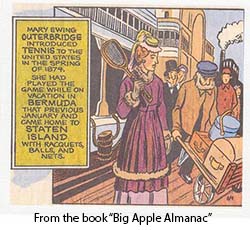 credited with bringing tennis to the U.S. Some 114 years ago, she arrived at the port of New York in possession of a tennis net and racquet only to have them confiscated by suspicious customs agents. Fortunately for the history of tennis in the U.S., her brother, a shipping executive, used his contacts and secured their release. Outerbridge had just returned from Bermuda, where she saw tennis being played, and went on to introduce it at the Staten Island Cricket and Baseball Club. She called the game "Sphairstiké", which is Greek for "playing at ball,", and laid out an hourglass-shaped court, which didn't prevent it from leap-frogging to places like Newport, R.I. and even New Orleans. The awkward name, never took hold however, so today we play tennis.
credited with bringing tennis to the U.S. Some 114 years ago, she arrived at the port of New York in possession of a tennis net and racquet only to have them confiscated by suspicious customs agents. Fortunately for the history of tennis in the U.S., her brother, a shipping executive, used his contacts and secured their release. Outerbridge had just returned from Bermuda, where she saw tennis being played, and went on to introduce it at the Staten Island Cricket and Baseball Club. She called the game "Sphairstiké", which is Greek for "playing at ball,", and laid out an hourglass-shaped court, which didn't prevent it from leap-frogging to places like Newport, R.I. and even New Orleans. The awkward name, never took hold however, so today we play tennis.
Resort and Camp News
Match Point Resorts, a tennis management company, has now taken over tennis operations at the WaterColor Tennis Center in Santa Rosa Beach in the Florida Panhandle. They have 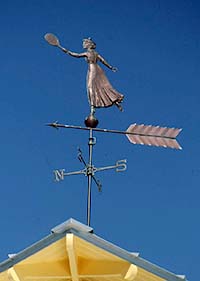 installed Malcolm Ridenour to direct operations on the handsome club's five Har-Tru courts. A USPTA Elite Pro, Ridenour has 20 years experience, that has includes stints at Northstar Tennis in Lake Tahoe and La Quinta Resort and Club in Palm Springs, the latter under both Tom Gorman and Lynne Rolley. At WaterColor he focuses on the weekly roster of daily drop in drills, doubles round robins, Cardio tennis, evening drills, and game matching. However, his responsibilities also extend to running the WaterColor tennis retreats Match Point Resorts organizes for doubles teams at several venues across the country, WaterColor newest among them. Those retreats utilize a teaching methodology developed by Match Point team member Daniel Nestor, whose stellar career includes 12 Grand Slam men's and mixed double titles (at all four venues), an Olympic Gold Medal, 91 doubles titles, and more than 1,000 career match wins.
installed Malcolm Ridenour to direct operations on the handsome club's five Har-Tru courts. A USPTA Elite Pro, Ridenour has 20 years experience, that has includes stints at Northstar Tennis in Lake Tahoe and La Quinta Resort and Club in Palm Springs, the latter under both Tom Gorman and Lynne Rolley. At WaterColor he focuses on the weekly roster of daily drop in drills, doubles round robins, Cardio tennis, evening drills, and game matching. However, his responsibilities also extend to running the WaterColor tennis retreats Match Point Resorts organizes for doubles teams at several venues across the country, WaterColor newest among them. Those retreats utilize a teaching methodology developed by Match Point team member Daniel Nestor, whose stellar career includes 12 Grand Slam men's and mixed double titles (at all four venues), an Olympic Gold Medal, 91 doubles titles, and more than 1,000 career match wins.
![]() In other resort and camp news, the Julian Krinsky School of Tennis (see Specials) has partnered with U.S. Sportscamps to market its programs at Villanova University, Haverford College, Narberth Tennis Club, and the Gulf Mills Club. … The Buccaneer on the U.S. Virgin Island of St. Croix has hired Roman Ramirez. … Hawk's Cay Resort on Florida's Duck Key was hard hit by hurricane Irma but will partially reopen March 16 with 100 villas and its Calm Waters Spa, Sunset Pool, Coral Cay kids' activities center, and Angler and Ale restaurant. The main hotel, with 177 guest rooms, is to reopen this summer. The tennis courts have yet to be resurfaced, however, so there is no firm date for the return of Cliff Drysdale Tennis's Hannah Thompson.
In other resort and camp news, the Julian Krinsky School of Tennis (see Specials) has partnered with U.S. Sportscamps to market its programs at Villanova University, Haverford College, Narberth Tennis Club, and the Gulf Mills Club. … The Buccaneer on the U.S. Virgin Island of St. Croix has hired Roman Ramirez. … Hawk's Cay Resort on Florida's Duck Key was hard hit by hurricane Irma but will partially reopen March 16 with 100 villas and its Calm Waters Spa, Sunset Pool, Coral Cay kids' activities center, and Angler and Ale restaurant. The main hotel, with 177 guest rooms, is to reopen this summer. The tennis courts have yet to be resurfaced, however, so there is no firm date for the return of Cliff Drysdale Tennis's Hannah Thompson.
Packages and Specials
Adult Tennis Camps
- Saddlebrook (Hopman) Tennis, Florida: Free Upgrade to 1-bedroom suite + Amenity Basket
- John Newcombe Tennis Ranch, Texas: Save $100 on any all-inclusive adult package
Junior Tennis Camps & Tournament Tours
- Julian Krinsky School of Tennis, Pennsylvania: $100 off resident camps; $50 off day camps
- Tennis: Europe and North America: $200 off package trips
